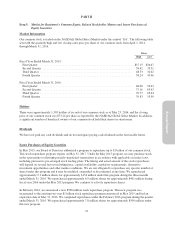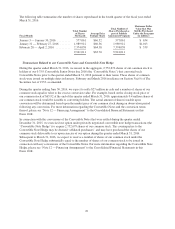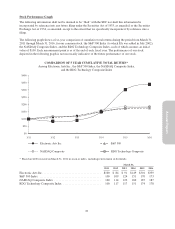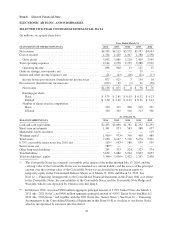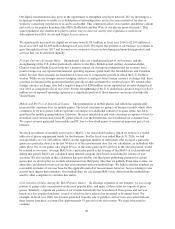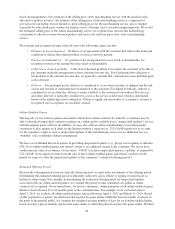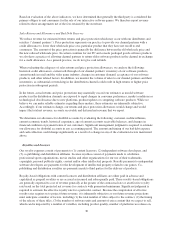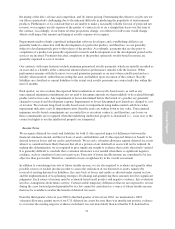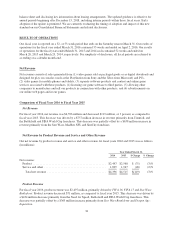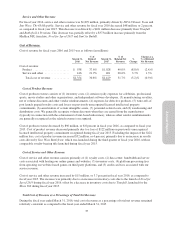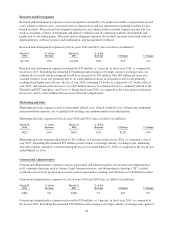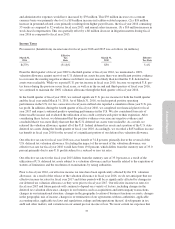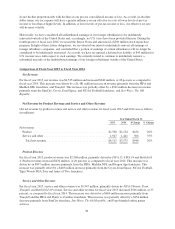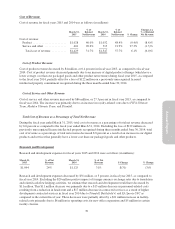Electronic Arts 2016 Annual Report Download - page 115
Download and view the complete annual report
Please find page 115 of the 2016 Electronic Arts annual report below. You can navigate through the pages in the report by either clicking on the pages listed below, or by using the keyword search tool below to find specific information within the annual report.
Annual Report
compute the weighted-average number of days for all online-enabled games by multiplying the weighted-average
number of days for each online-enabled game by its relative percentage of total units sold from these online-
enabled games (i.e., a game with more units sold will have a higher weighting to the overall computation than a
game with fewer units sold). Under a similar computation, we also consider the estimated period of time between
the date a game unit is sold to a reseller and the date the reseller sells the game unit to an end consumer (i.e., time
in channel). Based on these two calculations we then consider the method of distribution. For example,physical
software games sold at retail would have a composite offering period equal to the online gameplay plus time in
channel as opposed to digitally distributed software games which are delivered immediately via digital download
and thus have no concept of channel. Additionally, we consider results from prior analyses, known and expected
online gameplay trends, as well as disclosed service periods for competitors’ games in determining the estimated
offering period for future sales.
While we consistently apply this methodology, inherent assumptions used in this methodology include which
online-enabled games to sample, whether to use only units that have registered online, whether to weight the
number of days for each game, whether to weight the days based on the units sold of each game, determining the
period of time between the date of sale to reseller and the date of sale to the consumer and assessing online
gameplay trends.
Other Multiple-Element Arrangements
In some of our multiple-element arrangements, we sell tangible products with software and/or software-related
offerings. These tangible products are generally either peripherals or ancillary collectors’ items, such as figurines
and comic books. Revenue for these arrangements is allocated to each separate unit of accounting for each
deliverable using the relative selling prices of each deliverable in the arrangement based on the selling price
hierarchy described below. If the arrangement contains more than one software deliverable, the arrangement
consideration is allocated to the software deliverables as a group and then allocated to each software deliverable.
We determine the selling price for a tangible product deliverable based on the following selling price hierarchy:
VSOE (i.e., the price we charge when the tangible product is sold separately) if available, third-party evidence
(“TPE”) of fair value (i.e., the price charged by others for similar tangible products) if VSOE is not available, or
our best estimate of selling price (“BESP”) if neither VSOE nor TPE is available. Determining the BESP is a
subjective process that is based on multiple factors including, but not limited to, recent selling prices and related
discounts, market conditions, customer classes, sales channels and other factors. Provided the other three revenue
recognition criteria other than delivery have been met, we recognize revenue upon delivery to the customer as we
have no further obligations.
We must make assumptions and judgments in order to (1) determine whether and when each element is
delivered, (2) determine whether VSOE exists for each undelivered element, and (3) allocate the total price
among the various elements, as applicable. Changes to any of these assumptions and judgments, or changes to
the elements in the arrangement, could cause a material increase or decrease in the amount of revenue that we
report in a particular period.
Principal Agent Considerations
We evaluate sales of our interactive software games via third party storefronts, including digital storefronts such
as Microsoft’s Xbox Games Store, Sony PSN, Apple App Store, and Google Play, in order to determine whether
or not we are acting as the primary obligor in the sale to the end consumer, which we consider in determining if
revenue should be reported gross or net of fees retained by the storefront. Key indicators that we evaluate in
determining gross versus net treatment include but are not limited to the following:
• The party responsible for delivery/fulfillment of the product or service to the end consumer
• The party responsible for the billing, collection of fees and refunds to the end consumer
• The storefront and Terms of Sale that govern the end consumer’s purchase of the product or service
• The party that sets the pricing with the end consumer and has credit risk
29




